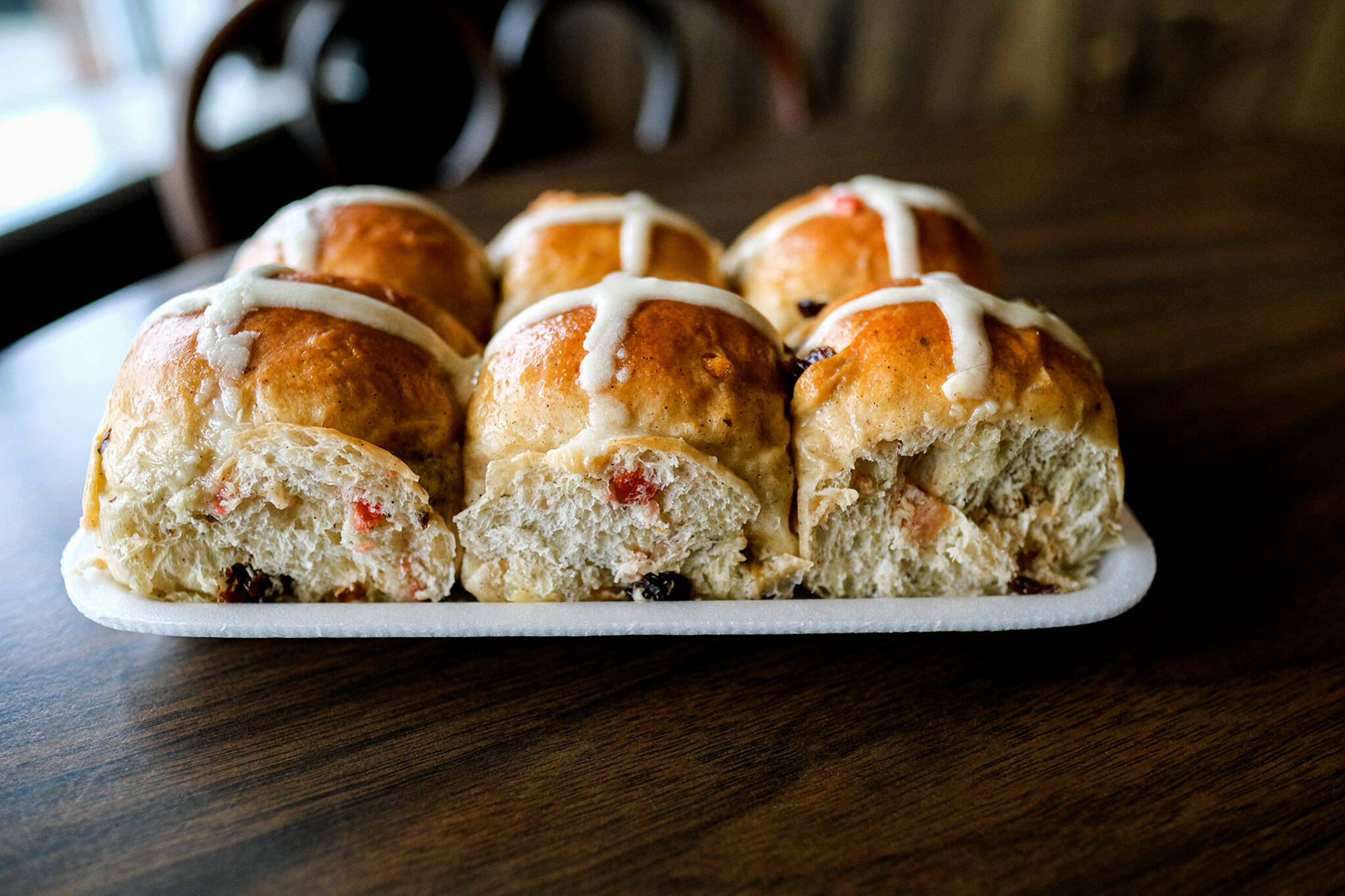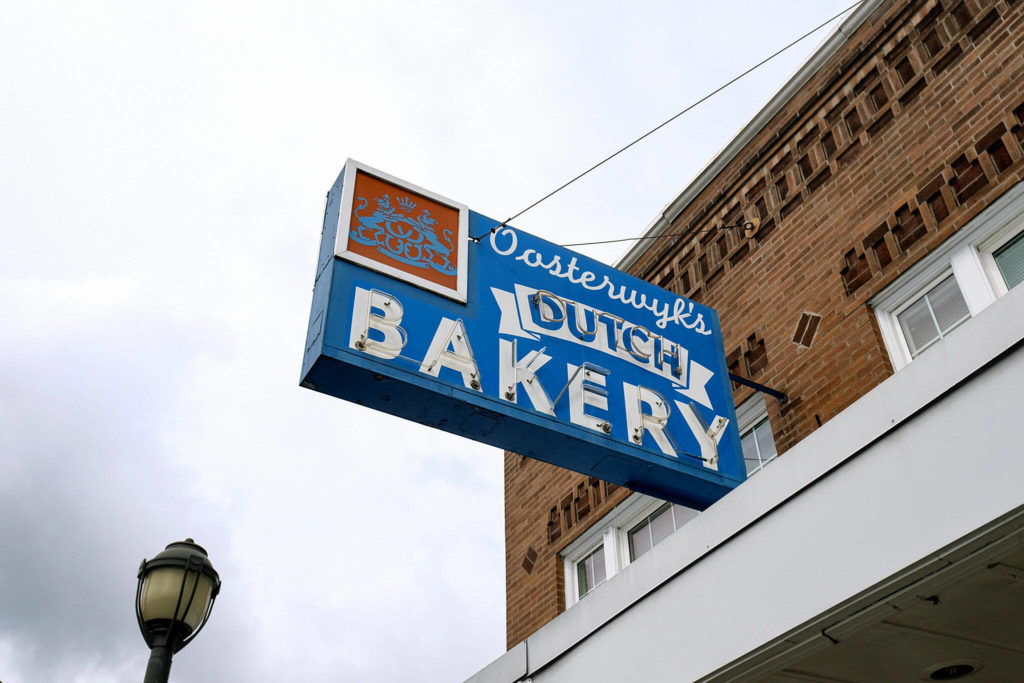Chocolate-covered matzo, a refreshing green sauce over halibut, or freshly made hot cross buns? Despite the symbolic prohibitions on certain foods during Passover and Good Friday, plenty of delicious foods will be enjoyed and celebrated this holiday weekend.
Friday marks great importance for those of Christian and Jewish faiths. Jewish observers will begin a seven- or eight-day celebration of the ancient Israelites’ escape from slavery in Egypt, known as Passover, or Pesach.
Many Christians will commemorate the crucifixion of Jesus Christ on Good Friday. Come Sunday, they will celebrate the resurrection of Jesus on Easter.
The Daily Herald compiled recipes and places to get some of these symbolic dishes.
Hot cross buns!
Oosterwyk Dutch Bakery in downtown Marysville has pre-orders for 60 dozen hot cross buns — on Good Friday alone. For folks not of the math persuasion, that amounts to 720 hot cross buns in a single day.
Traditionally eaten on Good Friday, the Marysville bakery’s hot cross buns are filled with green and red cherries, currants and raisins. They’re spiced with cardamom, are slightly sweet and fluffy like a dinner roll. The recipe comes from owner Marja Oosterwyk’s father, Gerard Oosterwyk.
“I’m proud of my business,” Marja said on Thursday, the day before the busy holiday weekend. “It’s a lot of work: Long hours and early days. But I love the bakery.”
Restaurants, bakeries and other food businesses across Snohomish County are ramping up traditional and symbolic dishes for the weekend. Take Oosterwyk’s hot cross buns. Choux Choux Bakery in Everett is also serving them on their Easter menu for pre-order or on a first-come, first-served basis, along with white and lemon cakes and cupcakes, cardamom braids and more.
Fish!
For Good Friday and Passover, my favorite way to eat salmon — other than basting it (skin on) with capers, garlic, lemon, butter and herbs — is Yotam Ottolenghi’s za’atar salmon and tahini, the recipe for which you can find on Food 52.
It is a simple, quick preparation with earthy za’atar, spinach, nutty tahini, puckering sumac and lemon. The salmon develops a sesame crust in the oven, while you get a nice creamy tahini sauce that doesn’t require any dairy.
And this easy recipe from “The Alaska Heritage Seafood Cookbook” calls for a super refreshing, simple and herbaceous sauce over halibut:
Halibut with Green Sauce
Submitted by: Dave and Margaret Olsen F/V “Major”
“This is a recipe from our niece Kate,” the couple wrote. “Make the sauce ahead, store in the fridge and you are always ready for a last minute delicious dinner.”
Green sauce*:
Two cups packed fresh parsley
One cup packed fresh basil
½ cup packed fresh cilantro
Two tablespoons fresh mint leaves
4 to 6 ounce halibut filets (choose number of filets based on your company)
Add sauce ingredients to a blender or food processor and combine ingredients until smooth. Add salt and pepper to taste and blend again until combined.
Broil, bake, grill or pan-fry the halibut until barely opaque in the center. Drizzle with green sauce to your liking and serve with rice, roasted veggies, salad and/or your preferred sides.
*You can store the sauce for up to eight weeks in a squeeze bottle or airtight container.
Taylor’s note: This recipe likely works for any white fish.
Matzo!
We can’t forget matzo, an unleavened flatbread eaten during Passover as a reminder that the Israelites had no time for their bread to rise during the Exodus from Egypt. My family usually eats it with butter (or margarine) and jam, though there are many ways to use this crunchy flatbread.
As a classic, The New York Times published Joan Nathan’s excellent matzo ball recipe (with dill! and fresh ginger!) that you can make ahead and freeze. For Passover (and throughout the year), my family also loved eating borscht. You can find this Ukrainian beet soup at Piroshky & Crepes European Bakery & Cafe in south Everett.
For dessert last year, I made matzo bark using David Lebovitz’s recipe for “chocolate-covered caramelized matzoh crunch.” You basically make a quick caramel (using brown sugar and butter or margarine) then pour over a baking sheet covered in matzo sheets and bake. Cover it with chocolate chips, let the heat melt the chips, spread it and let cool. I also added milk and white chocolate for aesthetics (and more chocolate).
David Lebovitz’s chocolate-covered caramelized matzoh crunch (adapted)
4 to 6 sheets unsalted matzo
1 cup (two sticks) unsalted butter (or margarine), cut into chunks
1 cup firmly-packed light brown sugar
big pinch of sea salt
½ teaspoon vanilla extract (Kosher for Passover, or omit)
1½ cups semisweet chocolate chips
3 to 4 ounces each of white and milk chocolate to top (optional)
Preheat the oven to 375 degrees.
Line a rimmed baking sheet up to the edges with foil, then top with parchment paper.
Place matzo on the sheet, breaking up some pieces to cover completely.
Cook the butter and brown sugar together over medium heat in a heavy sauce pan until the mixture begins to bubble. Boil for 3 minutes, stirring constantly. Remove from heat, then add salt and vanilla and stir. Pour caramel over matzo and quickly spread it with a heatproof spatula.
Place pan in the oven and immediately reduce heat to 350 degrees. Bake for 15 minutes. If some areas darken too quickly or begin to burn, remove the pan and adjust heat to 325 degrees. Return to oven and finish baking.
Remove pan from oven and immediately cover with the semisweet chocolate chips. Let stand 5 minutes to melt, then spread with a knife or spatula.
If using, melt the white and milk chocolate in separate bowls. Drop spoonfuls of each onto the matzo crunch, then swirl chocolates with a skewer, butter knife or fork.
Let cool completely. Break into pieces and serve, or store in an airtight container for up to one week.
Italian family recipe!
I grew up with a mixture of both Christian and Jewish customs (and food): My grandfather was a gruff, loving Italian Catholic from Patchogue, and my grandmother was an amazing, funny and fuzzy-haired Jewish woman born in the Bronx.
Needless to say, the kids and grandkids ate very, very well under the Valentino roof. Funny enough, we were not very religious. Holidays were more an excuse for the family to get together and eat lots of food. For Easter (and most Sundays, really), that meant a big plate of meatballs and pasta — I’ll share that recipe with you in good time. It was served with salad and plenty of garlic bread to mop up the balsamic vinaigrette and sauce (or gravy, to my fellow Italian-Americans).
For now, I’ll share a recipe I recently found in the Valentino Family Cookbook. My family compiled their favorite recipes in 1990, many of which predate that year, like this one for Easter pie.
It is basically antipasto in a pie and an excellent, meaty way for our Italian family to break Lent.
Easter Pie
1 pie crust (top and bottom), store bought or homemade
4 eggs
¼ pound pepperoni, chopped
¼ pound prosciutto, chopped
¼ pound salami, chopped
½ pound mozzarella, chopped
¼ cup Romano cheese, grated
1 pound ricotta
1 tablespoon dried parsley
Salt and pepper to taste
Preheat oven to 350 degrees. Beat eggs in a bowl, then add in the rest of the ingredients. Pour into the bottom pie crust and then layer on the top crust. Bake for 1 hour until golden brown. Let cool completely, cut into wedges and serve.
Taylor’s notes: You may need to cover the pie with aluminum foil to avoid the crust becoming too dark (or lower the temperature to 300 degrees for the last 30 minutes). I would say a deep dish pie pan or cake pan is best suited for this recipe. That’s a lotta ricotta!
Contact reporter Taylor Goebel at taylor.goebel@heraldnet.com or call 425-339-3046. Twitter: @TaylorGoebel. Join The Herald’s food-centered Facebook page, SnohomDish.
Talk to us
> Give us your news tips.
> Send us a letter to the editor.
> More Herald contact information.


























